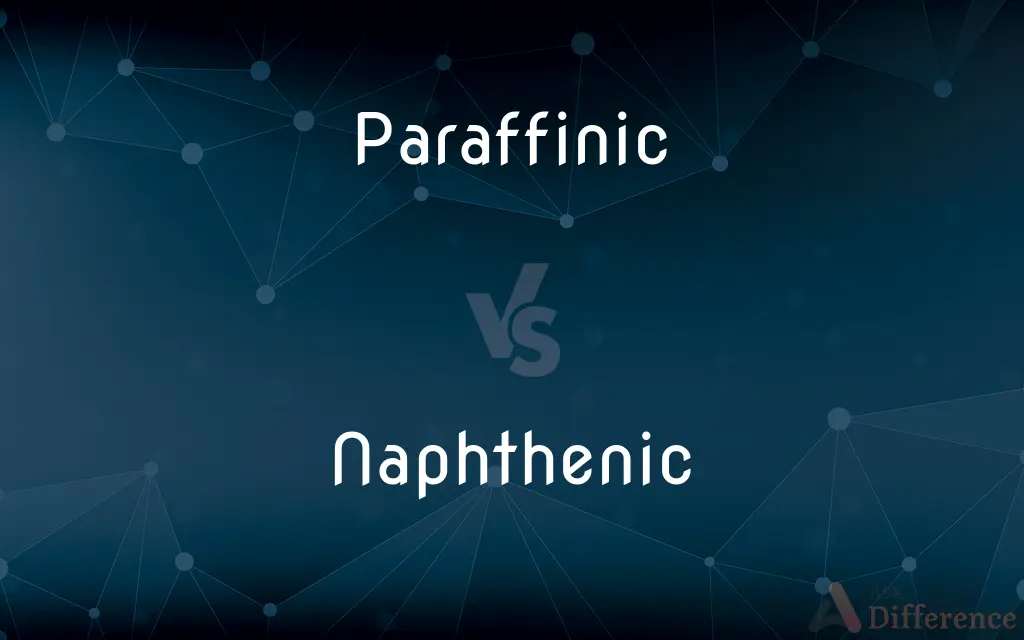Paraffinic vs. Naphthenic — What's the Difference?
Edited by Tayyaba Rehman — By Maham Liaqat — Updated on March 21, 2024
Paraffinic oils are characterized by high levels of saturated hydrocarbons, offering excellent stability and lubricity. Naphthenic oils, however, contain cyclic hydrocarbons, known for their low pour points and great solvency.

Difference Between Paraffinic and Naphthenic
Table of Contents
ADVERTISEMENT
Key Differences
Paraffinic oils, derived from crude oil with high paraffin content, are notable for their excellent thermal stability and high lubricating properties. These oils are often used in applications requiring stable, long-lasting lubrication. In contrast, naphthenic oils, which are rich in cyclic or naphthenic hydrocarbons, possess lower pour points, making them suitable for use in colder climates where fluidity at low temperatures is crucial.
The molecular structure of paraffinic oils, characterized by long chains of saturated hydrocarbons, contributes to their higher viscosity index and better resistance to oxidation. This makes them particularly useful in high-temperature applications. Naphthenic oils, with their ring-shaped molecular structure, exhibit better solvency and are able to dissolve a wider range of chemicals, making them ideal for use in the production of paints, inks, and similar products.
When it comes to refining processes, paraffinic oils require more extensive refining to remove waxes that can solidify at lower temperatures. This process, however, enhances their oxidative stability and extends their lifespan in high-performance applications. Naphthenic oils, due to their natural low pour points, do not need such extensive dewaxing, allowing them to maintain their fluidity in cold conditions without complex refining.
In lubricant formulation, the high lubricity of paraffinic oils makes them preferred choices for engine oils, industrial lubricants, and greases where wear protection is critical. Naphthenic oils, on the other hand, are often selected for specialty applications where low-temperature performance and high solvency are required, such as in transformer oils and metalworking fluids.
Despite their differences, both paraffinic and naphthenic oils play essential roles in various industrial and commercial applications. The choice between them depends on specific requirements like temperature performance, lubrication properties, and solvency needs.
ADVERTISEMENT
Comparison Chart
Hydrocarbon Type
High in saturated hydrocarbons (paraffins)
High in cyclic hydrocarbons (naphthenes)
Characteristics
High lubricity, excellent thermal stability
Low pour points, great solvency
Pour Point
Higher, due to long-chain hydrocarbons
Lower, suitable for cold climates
Oxidative Stability
Better, due to saturated molecular structure
Lesser compared to paraffinic
Applications
Engine oils, industrial lubricants
Transformer oils, paints, inks
Solvency
Lower
Higher, can dissolve more substances
Refining Process
Requires extensive refining to remove waxes
Less intensive refining needed
Viscosity Index
Higher
Lower
Usage
Preferred in high-temperature settings
Preferred where low-temperature fluidity is needed
Compare with Definitions
Paraffinic
Requires extensive refining to reduce wax content.
Paraffinic crude oils undergo dewaxing to improve cold flow properties.
Naphthenic
Does not require extensive refining for cold weather performance.
The natural composition of naphthenic oils reduces the need for dewaxing.
Paraffinic
Less effective at low temperatures due to solidification of waxes.
In colder environments, paraffinic oils may require additives to improve flow.
Naphthenic
Preferred in applications requiring good solubility and low-temperature fluidity.
Transformer oils often use naphthenic bases for their excellent electrical properties and cold-weather performance.
Paraffinic
High oxidative stability and lubricity.
The lubricant's paraffinic base ensures long-term engine protection.
Naphthenic
Lower viscosity index compared to paraffinic oils.
Naphthenic oils may thin out more quickly at higher temperatures.
Paraffinic
Higher viscosity index than naphthenic oils.
Paraffinic oils maintain their viscosity better over a wide temperature range.
Naphthenic
Contains cyclic hydrocarbons with lower pour points.
Naphthenic oils remain fluid and effective even in extremely cold conditions.
Paraffinic
Characterized by long-chain saturated hydrocarbons.
Paraffinic oils are preferred for high-temperature industrial applications.
Naphthenic
Excellent solvency, suitable for chemical and paint industries.
The solvency of naphthenic oils makes them ideal for dissolving complex chemicals in formulations.
Paraffinic
A waxy white or colorless solid hydrocarbon mixture used to make candles, wax paper, lubricants, and sealing materials. Also called paraffin wax.
Naphthenic
Any of several cycloalkane hydrocarbons having the general formula CnH2n and found in various petroleums.
Paraffinic
(Chemistry) A member of the alkane series.
Naphthenic
(chemistry) Of, pertaining to, or derived from a naphthene.
Paraffinic
Chiefly British Kerosene.
Paraffinic
To saturate, impregnate, or coat with paraffin.
Paraffinic
Of or pertaining to paraffin, or to the alkanes
Paraffinic
Aliphatic
Common Curiosities
What are paraffinic oils?
Paraffinic oils are lubricants derived from crude oil with high levels of saturated hydrocarbons, known for their lubricity and thermal stability.
Why are naphthenic oils preferred in the paint industry?
Their excellent solvency allows for the effective dissolution of resins and pigments, making them suitable for paints and inks.
Can paraffinic oils be used in all engines?
While paraffinic oils are widely used in various engines, their specific suitability depends on the engine design and operating conditions.
How do the refining processes for paraffinic and naphthenic oils differ?
Paraffinic oils require extensive dewaxing to improve cold flow properties, whereas naphthenic oils require less intensive refining due to their natural low pour points.
Why are naphthenic oils used in cold climates?
Their lower pour points ensure that they remain fluid at lower temperatures, making them ideal for cold climate applications.
Can additives improve the cold flow properties of paraffinic oils?
Yes, pour point depressants and other additives can enhance the cold weather performance of paraffinic oils.
What makes paraffinic oils have a higher viscosity index?
Their long-chain saturated hydrocarbon structure makes them less prone to thinning with temperature increases.
What role does solvency play in oil applications?
Solvency determines an oil's ability to dissolve other substances, affecting its suitability for various applications like paints or chemical processes.
What is the significance of oxidative stability in oils?
Oxidative stability affects an oil's lifespan and performance, particularly in high-temperature environments.
How do environmental conditions affect the choice between paraffinic and naphthenic oils?
The choice often depends on temperature conditions and the need for lubrication stability or solvency.
Are naphthenic oils less stable than paraffinic oils?
Naphthenic oils tend to have lesser oxidative stability due to their cyclic hydrocarbon structure.
Why might an application require a lubricant with a high viscosity index?
A high viscosity index indicates the lubricant's effectiveness over a broad temperature range, essential for applications subject to temperature fluctuations.
Share Your Discovery

Previous Comparison
Dormitory vs. Accommodation
Next Comparison
Harsh vs. SevereAuthor Spotlight
Written by
Maham LiaqatEdited by
Tayyaba RehmanTayyaba Rehman is a distinguished writer, currently serving as a primary contributor to askdifference.com. As a researcher in semantics and etymology, Tayyaba's passion for the complexity of languages and their distinctions has found a perfect home on the platform. Tayyaba delves into the intricacies of language, distinguishing between commonly confused words and phrases, thereby providing clarity for readers worldwide.
















































